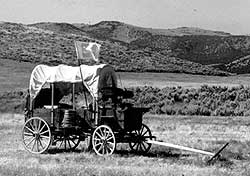Birth
of the Trails
For various reasons, in
the 1830s and 1840s, interest began to grow throughout the settled parts of
the United States in the area west of the Mississippi River. Here was land for
the taking, places where people could get a new start in life. There were newspaper
articles praising the little-known areas. Returning missionaries told of the
wonders of the distant lands. A few people started out and the trickle of settlers
grew.
Mountain men knew the
way. There were animal trails to follow, streams and rivers to furnish water
and enough feed for animals. The pioneering spirit of the country was aroused.
 |
| Replica
of Oregon Trail wagon, east of Declo, Idaho, (July 1993). Wagon was part
of the sesquicentennial (150th anniversary) Oregon Trail wagon train. |
This was not an organized
migration. The government did not establish programs to encourage travel to
the West. No roads were built, no preparations for a mass movement of settlers
were undertaken. The whole idea just grew. Small groups of people would decide
to go west. Parties would gather at jumping off places where they joined others
who were ready to go and a wagon train would be organized.
For the first few years,
before guidebooks became available, it was necessary for a wagon train to hire
a leader, usually a retired fur trapper, who knew the country and could help
the inexperienced travelers find their way. Some of the pioneers were experienced
in handling large numbers of animals and did not find the prospect of a 4 or
5 month trip into a wilderness to be daunting. Many, however, were from cities
in the east or mid-west and had no concept of what they were getting into. It
took a lot of courage, and not everyone had it. Many turned back.
Life was less complicated
then. The American diet was limited and the usual foods could be carried easily.
Barrels of flour or corn meal, in which eggs were stored for safe carrying,
sides of salt pork and bags of beans made up the usual fare. Travelers expected
to supplement these staples on the trail with vegetables, fish and game. Clothing
was rough and simple.
The large Conestoga wagons,
used in an earlier time when east coast settlers were moving into the Mississippi
area, were unsuited for this movement. They were too bulky and heavy. Instead,
the pioneers used smaller, slab-sided wagons which could be floated across streams.
These were pulled either by horses or oxen. Families took everything they owned
and brought all of their animals. The draft animals would be used in farming when
the trip was over.
top

